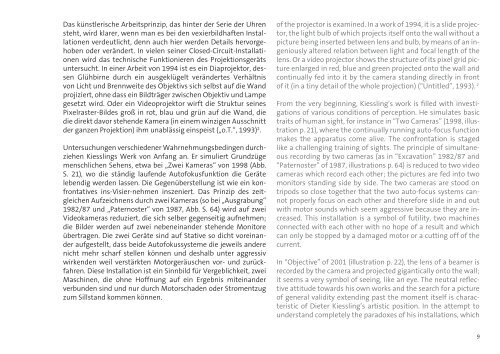DIETER KIESSLING - home
DIETER KIESSLING - home
DIETER KIESSLING - home
Sie wollen auch ein ePaper? Erhöhen Sie die Reichweite Ihrer Titel.
YUMPU macht aus Druck-PDFs automatisch weboptimierte ePaper, die Google liebt.
Das künstlerische Arbeitsprinzip, das hinter der Serie der Uhren<br />
steht, wird klarer, wenn man es bei den vexierbildhaften Installationen<br />
verdeutlicht, denn auch hier werden Details hervorgehoben<br />
oder verändert. In vielen seiner Closed-Circuit-Installationen<br />
wird das technische Funktionieren des Projektionsgeräts<br />
untersucht. In einer Arbeit von 1994 ist es ein Diaprojektor, dessen<br />
Glühbirne durch ein ausgeklügelt verändertes Verhältnis<br />
von Licht und Brennweite des Objektivs sich selbst auf die Wand<br />
projiziert, ohne dass ein Bildträger zwischen Objektiv und Lampe<br />
gesetzt wird. Oder ein Videoprojektor wirft die Struktur seines<br />
Pixelraster-Bildes groß in rot, blau und grün auf die Wand, die<br />
die direkt davor stehende Kamera (in einem winzigen Ausschnitt<br />
der ganzen Projektion) ihm unablässig einspeist („o.T.“, 1993) 2 .<br />
Untersuchungen verschiedener Wahrnehmungsbedingen durchziehen<br />
Kiesslings Werk von Anfang an. Er simuliert Grundzüge<br />
menschlichen Sehens, etwa bei „Zwei Kameras“ von 1998 (Abb.<br />
S. 21), wo die ständig laufende Autofokusfunktion die Geräte<br />
lebendig werden lassen. Die Gegenüberstellung ist wie ein konfrontatives<br />
ins-Visier-nehmen inszeniert. Das Prinzip des zeitgleichen<br />
Aufzeichnens durch zwei Kameras (so bei „Ausgrabung“<br />
1982/87 und „Paternoster“ von 1987, Abb. S. 64) wird auf zwei<br />
Videokameras reduziert, die sich selber gegenseitig aufnehmen;<br />
die Bilder werden auf zwei nebeneinander stehende Monitore<br />
übertragen. Die zwei Geräte sind auf Stative so dicht voreinander<br />
aufgestellt, dass beide Autofokussysteme die jeweils andere<br />
nicht mehr scharf stellen können und deshalb unter aggressiv<br />
wirkenden weil verstärkten Motorgeräuschen vor- und zurückfahren.<br />
Diese Installation ist ein Sinnbild für Vergeblichkeit, zwei<br />
Maschinen, die ohne Hoffnung auf ein Ergebnis miteinander<br />
verbunden sind und nur durch Motorschaden oder Stromentzug<br />
zum Sillstand kommen können.<br />
of the projector is examined. In a work of 1994, it is a slide projector,<br />
the light bulb of which projects itself onto the wall without a<br />
picture being inserted between lens and bulb, by means of an ingeniously<br />
altered relation between light and focal length of the<br />
lens. Or a video projector shows the structure of its pixel grid picture<br />
enlarged in red, blue and green projected onto the wall and<br />
continually fed into it by the camera standing directly in front<br />
of it (in a tiny detail of the whole projection) (“Untitled”, 1993). 2<br />
From the very beginning, Kiessling’s work is filled with investigations<br />
of various conditions of perception. He simulates basic<br />
traits of human sight, for instance in “Two Cameras” (1998, illustration<br />
p. 21), where the continually running auto-focus function<br />
makes the apparatus come alive. The confrontation is staged<br />
like a challenging training of sights. The principle of simultaneous<br />
recording by two cameras (as in “Excavation” 1982/87 and<br />
“Paternoster” of 1987, illustrations p. 64) is reduced to two video<br />
cameras which record each other; the pictures are fed into two<br />
monitors standing side by side. The two cameras are stood on<br />
tripods so close together that the two auto-focus systems cannot<br />
properly focus on each other and therefore slide in and out<br />
with motor sounds which seem aggressive because they are increased.<br />
This installation is a symbol of futility, two machines<br />
connected with each other with no hope of a result and which<br />
can only be stopped by a damaged motor or a cutting off of the<br />
current.<br />
In “Objective” of 2001 (illustration p. 22), the lens of a beamer is<br />
recorded by the camera and projected gigantically onto the wall;<br />
it seems a very symbol of seeing, like an eye. The neutral reflective<br />
attitude towards his own works and the search for a picture<br />
of general validity extending past the moment itself is characteristic<br />
of Dieter Kiessling’s artistic position. In the attempt to<br />
understand completely the paradoxes of his installations, which<br />
9


